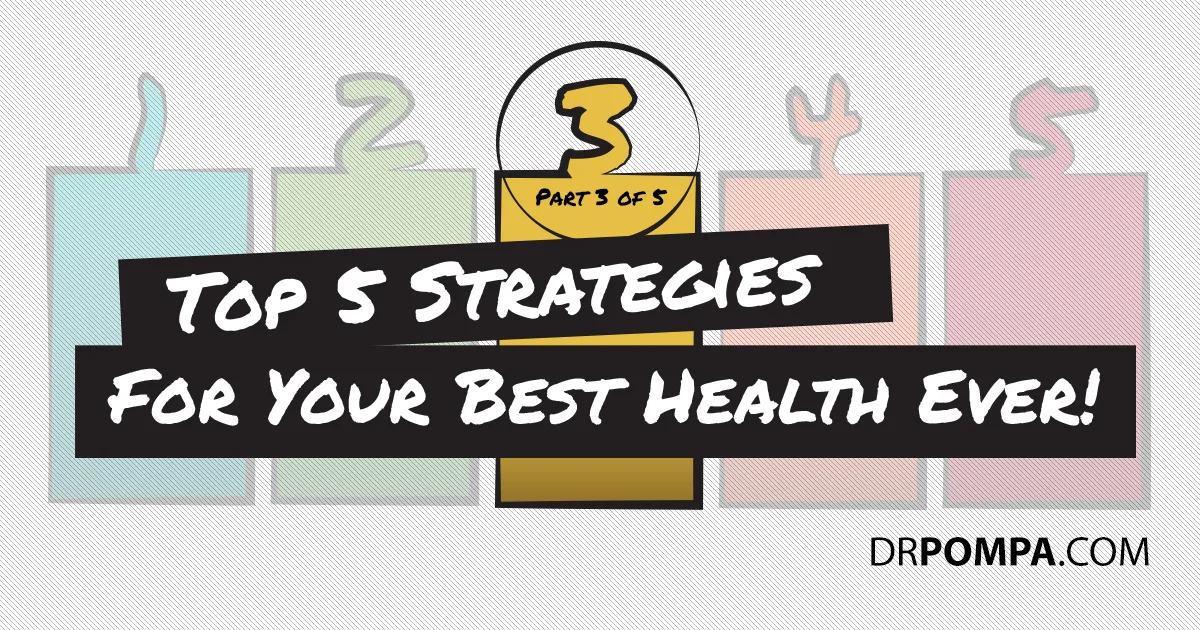180° Solution™ Strategy #3: Intermittent Fasting
If you’ve been following my work for any period of time you know I’m a huge believer in the power of fasting and intermittent fasting to decrease cellular inflammation and ignite healing in the body (read a previous article here). Fasting means abstaining from all or some kinds of food or drink for a specified time period, and has been used since ancient times to get sick people well. It is not a magic quick-fix cure, but merely allows the body’s innate healing mechanisms to be triggered by removing the obstacles to healing (R1: Remove the Source). By letting the body exclusively focus on healing itself, restoration is accelerated. Although many health practitioners today are hesitant to recommend fasting and intermittent fasting due to misinformation and stigma, it nevertheless remains one of the simplest yet most profound ways to improve health at the most basic cellular level. Incorporating the practice properly has provided incredible benefits for me personally, as well as those I coach back to health. An ancient healing tool still fit for modern health challenges … Let’s dive in more.
Intermittent Fasting – A Top 5 Strategy To Create Your Best Health Ever!
Slaying the Silent Killer and Other Benefits
The main reason I believe fasting markedly improves most every health condition is that is downregulates cellular inflammation. There are two types of inflammation: chronic and acute. Acute inflammation lasts just a short period of time (between seconds and a few days), and is a normal and healthy biological response to wound healing or infection. Chronic inflammation, on the other hand, occurs over a longer time period (often many years), is not healthy, and is directly implicated in most all modern health disorders, including autoimmune disease, obesity and diabetes, hormone challenges, and more. To impact most any health challenge we must decrease chronic inflammation, aka the “silent killer.” And there is simply no quicker way to decrease inflammation than fasting.
In addition, a recent study suggested that fasting for three consecutive days actually “flips a switch” to ignite regeneration of the immune system as it triggers the body to begin producing new white blood cells. It’s akin to pressing the reset button on your body’s wiring system. The study also found that prolonged fasting triggered a reduction of the enzyme PKA, linking to aging and increased risk of cancer and tumor growth. Dr. Valter Longo, Professor of Gerontology and the Biological Sciences at the University of California, stated “There is no evidence at all that fasting would be dangerous while there is strong evidence that it is beneficial.”
And the benefits of fasting don’t stop there. Fasting and daily intermittent fasting also spikes human growth hormone (HGH) levels, which offer strong anti-aging effects by literally slowing the rate at which your cells age. Fasting also dramatically increases energy levels since the body isn’t burdened by digesting food all day. Without the burden of digesting, the gut is able to heal from conditions like IBS, leaky gut and other sever inflammation driven conditions like Crohn’s and colitis.
Other positive side effects of fasting and intermittent fasting include: weight-loss, increased brain function and cognitive skills, powerful detoxification (GCELL & BIND) effects, life extension, improved hormone balance and insulin sensitivity, enhanced digestion, decreased disease risk, reduced appetite, and the list goes on.
Animals: Smarter than Humans?
Animals: Smarter than Humans?
Interestingly, we can observe fasting in nature. Animals appear to be innately smarter than humans in terms of knowing what to do with their bodies in times of sickness and injury. Dr. Felix Oswald, author of “Fasting Hydropathy and Exercise” (published in 1900) says: “Serious sickness prompts all animals to fast.” In times of physical distress, animals instinctively fast, which gives their bodies the needed time to heal and repair. Humans are the only beings in nature who continue to eat while sick. And although we possess a higher intelligence, and remain in our own category, our bodies function in similar ways. Therefore, what causes animals to fall ill often affects us, and what helps them heal can support our health too.
Eating and digesting food requires an extreme amount of energy from the body. Recall the physical feeling of a decadent post-Thanksgiving meal. You’re likely quite lethargic after that last slice of pumpkin pie because the body has to work overtime to process the considerable amount of food consumed. And when our body is busy digesting food, it can’t shift into the natural mode of healing, where it can exclusively focus on detoxification and repair. Animals do not distract their bodies with the energy-sucking process of digesting and assimilating food when they are trying to heal. They simply follow their instincts and rest, drink water and avoid eating. Smarter than we are? Food for thought (pardon the pun).
Animals also fast during times of food scarcity to survive and continue to reproduce. They also fast during hibernation in the cold season since they don’t need much fuel as energy expenditure is reduced. Some fast immediately after birth, when not hungry (no kidding!), if feeling angry or excited, and when they are wounded to accelerate cellular repair. Some animals even support a fellow wounded member of their herd or pack by fasting alongside the injured soldier. True solidarity.
Starvation vs. Strategic Eating
“To rise at six, dine at ten, sup at six and go to bed at ten, makes a man live ten times ten.” – 16th century proverb
Now there’s a big difference between pushing a plate of food away before you’re satiated contrasted with strategically regulating calorie intake. We already know caloric restriction doesn’t work. Starving yourself forces the metabolism to go lower and lower, hanging on to every calorie consumed. Did our ancestors leave food behind to go to waste? Nope, they ate until they were full every time. But they also didn’t sit down to three large meals a day plus snacks. Eating was sporadic, so they feasted when food was aplenty and fasted when food was absent; however, over the course of the day they consumed far less calories than we now do. Our ancestors were fasting and reaping all the benefits, and didn’t even know it (for more info see our 5-1-1 rule post).
Fortunately, we can take advantage of the sporadic eating practice that kept our ancestors’ lean, mean, fighting machines by employing a simple type of fasting known as intermittent fasting. I practice intermittent fasting on a daily basis by fasting for 16-18 hours each day. Sound crazy? It’s actually much easier than you may think. Plus, by using this approach I gain most all the benefits of a longer fast while still enjoying my favorite foods. Here’s how I do it: I skip breakfast, often just drinking organic coffee with plenty of MCT oil and/or grass-fed heavy cream. The good fat helps to turn your brain “on” in the morning and also functions to stabilize blood sugar levels till the first meal of the day. Between 1PM and 3PM I eat a light lunch of protein and high quality fat (see, “Does Fat Make You Fat?” for more) to keep my energy steady as I power through the day. Finally, I feast like a Roman soldier in the evenings between 5PM and 8PM, consuming quality fat, protein, and healthy carbs (most often in the form of veggies). The foods I eat follow core principles of my Cellular Healing Diet. The act of intermittent fasting has changed my body in profound ways, and it’s the game-changing technique that has increased my health like never before. I can honestly say that of all the natural health practices I have used in the last 10 years it has been the most profound.
Some classic wisdom on daily meal frequency:
“During the zenith period of Grecian and Roman civilization monogamy was not as firmly established as the rule that a health-loving man should content himself with one meal a day, and never eat till he had leisure to digest, i.e., not till the day's work was wholly done. For more than a thousand years the one meal plan was the established rule among the civilized nations inhabiting the coast-lands of the Mediterranean. The evening repast–call it supper or dinner–was a kind of domestic festival, the reward of the day's toil, an enjoyment which rich and poor refrained from marring by premature gratifications of their appetites.” – Dr. Felix Oswald
Practically speaking, fasting is also a great strategy for the on-the-go lifestyle. Since you go for longer periods of time without food, you can avoid eating questionable fare on the road. On travel days, when in and out or airports, I simply fast until evening when I can eat a well-balanced, healthy meal that will make me feel good. The strategy works very well, and allows me to remain energized and peaceful during transit. Fasting is also budget-friendly. By eating less food you, of course, spend less money on groceries. Perhaps you would choose to spend the money saved on the highest quality foods you can afford so you can eat the most nutrient dense diet possible. Quality over quantity.
You may be wondering… am I hungry while fasting? Rarely, because my blood sugar is effortlessly regulated since my body is in an efficient fat burning mode. Therefore, I’m no longer a “sugar burner” relying upon glucose for fuel (i.e. most all Americans). Nope, I’m a “fat burner” using my body’s own fat stores for energy. This fat-burning mode is called ketosis, which has many benefits and I’ve written about extensively here and here. I also discussed ketosis in the previous article in this five part series, Health Strategy #2 (link). But ultimately, if I do experience some hunger, the benefits gained are more than worth it. And who says a little hunger is a bad thing, anyway?
Keys to Successful Intermittent Fasting
Considering how our bodies were designed, it makes sense that intermittent fasting positively impacts the body. The method works in harmony with our circadian rhythms given that humans are inherently nocturnal eaters, as evidenced by our nervous system. Fasting during the day kicks the sympathetic (“fight or flight”) nervous system into gear, in a good way, for all-day energy and vitality. Later on, the evening “feast” of good fat, protein and carbs functions to raise blood sugar enough to trigger the parasympathetic nervous system response to promote relaxation and lull you off to peaceful slumber. The large nightly meal also informs the body that it is not starving, so there’s no need to hang on to stored fat. Therefore, your body burns your stored fat for lasting energy. This is truly how you finally dip into those hard to burn areas that never leave no matter how much you exercise or what you eat. Note: If you don’t eat enough at dinner while you’re intermittent fasting, your body will remain in sympathetic mode and believe it’s not getting enough food to survive. It will then hang on to every calorie, keep you awake at night, tax your adrenal glands, and you will not realize the benefits. Worse yet, you will lose muscle and gain fat, the same thing that happens on caloric restricted diets.
Also, due to less overall food consumption while fasting, it’s crucial to make every calorie count by eating a very nutrient rich diet. I suggest consuming plenty of healthy fats, grass-fed and pastured animal protein, cultured, grass-fed dairy, and organic, non-GMO veggies and low-glycemic fruits, following principles of my Cellular Healing Diet, to ensure nutritional bases are covered. I’ve also found it helpful to consume good fat in the morning to stabilize blood sugar levels and keep you in the fat-burning zone until lunchtime, which still qualifies as intermittent fasting. Try adding plenty of coconut oil, coconut milk, grass-fed butter or butter oil and/or grass-fed heavy cream to your organic coffee or tea to start your day off right. I find the warm coffee or tea first thing in the morning satisfies the comfort we need when we first arise and takes away the psychological need for food.
The Myth of Mini-Meals to Rev Up Metabolism
What about the popular weight-loss theory of eating 5-6 mini meals a day, which allegedly keeps the metabolism running all day? Well, it might help you drop a few pounds in the short-term, but there’s a price to pay. If you’re eating around the clock, the pancreas is constantly releasing the hormone insulin and raising your blood sugar, which ultimately accelerates the aging process via the release of AGES (Advanced Glycation End Products). Recall Health Strategy #1: the key to anti-aging and longevity is controlling blood sugar. When you’re always eating, the body never gets the chance to burn stored fat because it’s too busy metabolizing food. Dispel this antiquated advice and “think 180” by experimenting with intermittent fasting and watch what happens to your health.
When you look at all the studies on aging the message is pretty clear. If you want to age faster, eat more. If you want to age slower, eat less. However, when we look at cultures like the Okinawans, who eat much less and live much longer, they all eat to fullness. Meaning they are not pushing food away on a caloric restrictive diet; they are simply efficient fat burners and are not hungry. People always say to me, “You haven’t eaten all day”, and I say “No, I ate all day” as I am grab my own fat. When you are an efficient fat burner you are able to use your own fat stores for fuel, which provides perfect insulin and glucose levels all day with no spikes. That means you have no cravings and live longer, leaner.
Fasting Techniques: What's Best for You?
There are various methods of fasting other than daily intermittent fasting, including taking one or two days a week to fast, or the block fasting approach, which involves fasting for consecutive days at a time. I sometimes like to take one day a week as a fasting day, while still including daily intermittent fasting in my routine.
I often have challenged clients do a 4-day block fast on probiotic-rich whey water or 100% grass-fed beef bone stock once or twice a month, which acts as an incredibly effective immune system reboot because it heals the gut and decreases inflammation (R4). However, eating within a daily compressed time window (intermittent fasting) allows me to reap most all of the benefits of longer block fasts while still allowing me to eat my favorite healing foods at dinner. It’s a win-win.
A Tool for Transformation
Fasting is simply another tool to keep in your toolbox of health strategies. The beauty lies in its simplicity and its amazing way of decreasing cellular inflammation. I’ve had much personal and clinical success with the technique, but it doesn’t mean it’s the perfect solution for you. All you can do is give it a try, keep an open mind, and stay in tune with your body. If you’d like to experiment, you can begin the transition from sugar burner to fat burner by putting yourself into ketosis. Once in ketosis, your body is burning your own fat for fuel so you can go for longer periods without food, i.e. intermittent fasting, and not get that dreaded “hangry” feeling. Remember to incorporate the diet variation technique (see Health Strategy #2 here) if you’re not getting results.
Now, if you really want to supercharge fat-loss (especially whilst in ketosis), boost anti-aging growth hormone, and get leaner than ever before, you must implement this next strategy…
Stay tuned for the next 180° Solution™ strategy #4 for your best health ever!
Other Articles in this Series:
Strategy 1: Controlling Blood Sugar
Strategy 4: Burst Training
Strategy 2: Diet Variation
Strategy 5: PompaCore Cellular Detox™
Key Takeaways for Implementing Diet Variation:
- Experiment with daily intermittent fasting, 1 day per week fasting, or a 3-4 day block of fasting and see what works best for you.
- Due to less overall food consumption while fasting, make every calorie count by eating a very nutrient rich diet. Consume plenty of healthy fats, quality animal protein, and organic vegetables (following core principles of my Cellular Healing Diet) to ensure nutritional bases are covered.
- Take in good fat in the morning to stabilize blood sugar levels and to keep you in the fat-burning zone until lunch time. Try adding plenty of coconut oil, coconut milk, grass-fed butter oil or grass-fed heavy cream to your organic coffee or tea.
- Be patient with yourself as you transition from a “sugar burner” to a “fat burner,” and incorporate the diet variation (see Strategy #2) if weight loss plateaus.
Top 5 Strategies for Your Best Health Ever Part II
Edited by Meredith Dykstra








